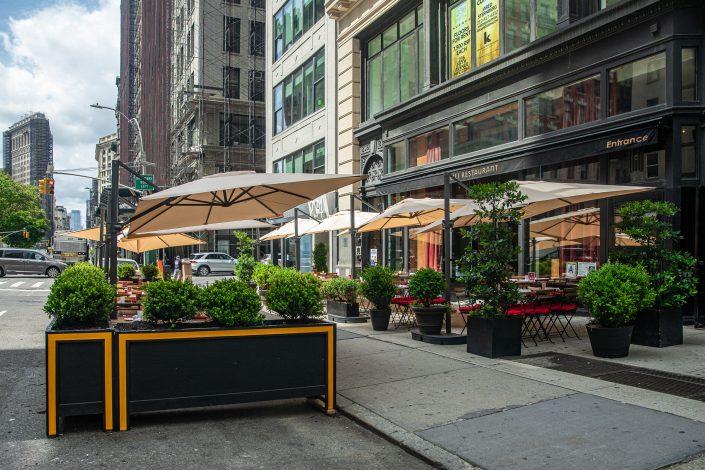Since opening ilili in 2008, restaurateur Philippe Massoud had expanded his upscale Lebanese eatery to three locations around Manhattan. But Covid cut deeply into his business — as it did with thousands of others across the city — forcing Massoud to close two locations and exit those leases. He has managed to keep his Flatiron District venue alive after spending nearly $20,000 on pricey umbrellas, planters, tables and chairs to take advantage of the city’s outdoor dining program.
But with winter in the distance and unanswered questions about how open-air dining will operate in frigid temperatures, Massoud was apprehensive and a bit poetic about the future.

ilili’s outdoor setup, tailored for the warm months (Courtesy of ilili)
“We are first of all partners with Mother Earth and the weather,” Massoud said. But he added, if city officials “don’t want the real estate market to crash, and they don’t want a 1929-style cataclysmic depression, they better come up with something, because we are slowly marching to our graves.”
The city’s Open Restaurants program, which began in June, has eased outdoor dining regulations on businesses. With indoor dining still prohibited in the five boroughs and no word on when it may return, Mayor Bill de Blasio extended the program through Oct. 31 — it was originally to end on Labor Day — with the possibility it could last into winter. But that potential has so far come without new guidance for restaurants whose outdoor spaces — on sidewalks and streets — cannot have a fixed roof.
“Ambiguity makes life challenging for restaurant operators,” said Taylor Mondshein, executive search consultant at the Elliot Group.
The same goes for landlords who are already grappling with tenants unable to pay their full rent and many others who have bailed out entirely.
According to the New York City Hospitality Alliance’s July survey, 71 percent of restaurant and bar owners said landlords have not waived any of their rent, and about 60 percent said landlords had not deferred rent or renegotiated their lease.
Out in the cold
Few industry pros interviewed saw long-term viability in outdoor dining, especially when the cold weather comes.
“I think that people are expecting there to be some form of indoor dining by [the winter],” said Alex Victor, a partner in the law firm Davidoff Hutcher & Citron, which represents over 100 bars and restaurants in New York. Outside the city, New York restaurants have for weeks been serving diners indoors at 50 percent of capacity and the Covid infection rate has continued to ebb.
Under city regulations, sidewalk cafes can install portable natural gas heaters only after receiving approval from both the Department of Buildings and the Fire Department. Only two different models of heaters and one type of gas hose are approved for use.
Current guidelines show approval can take at least 25 business days and entail nearly $200 in fees.
That’s in addition to the heaters themselves, which can run anywhere from $150 to $1,000 each, according to Jennifer Carpenter, a principal at Verona Carpenter Architects.
“In New York, the only way people will come sit outside in the winter [is] if they are comfortable,” Carpenter said. “It’s going to be something that’s necessary. The bigger question is the economics of, ‘even if I pack my outdoor cafe [with heaters], can I stay open?’”
Roughly 9,000 restaurants have been approved for the city’s Open Restaurants program, keeping an estimated 80,000 people employed, city officials said.
But many of those restaurant owners are struggling to pay the bills. Last month, 83 percent of eateries did not pay full rent and 37 percent paid no rent at all, according to the Hospitality Alliance’s survey of nearly 500 restaurant and bar owners.
Paul Ficalora, a restaurant broker and real estate agent, said whatever the city does to ease outdoor dining in the winter likely won’t be enough for many restaurant owners to pay the bills and the rent.
“There are city people that are walking away,” he said, “and looking for opportunities north of the city.”
Contact Sasha Jones at sasha.jones@therealdeal.com
